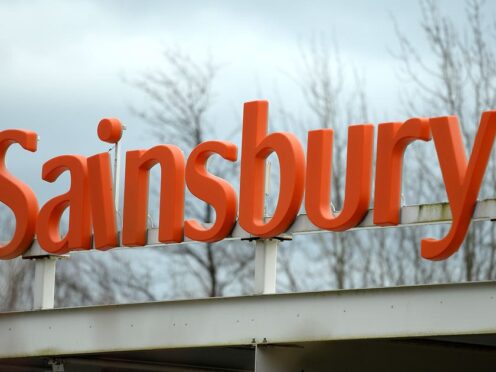The boss of Sainsbury’s has refused to rule out job losses under plans to slash costs by £1 billion as the chain revealed it will cut general merchandise and clothing space and expand its food offering.
The UK’s second biggest supermarket unveiled a strategy update that will see it boost food space across all its near-600 supermarkets, while focusing expansion efforts on 180 of its “highest potential” sites, which will see about 10% more space dedicated to food.
But it will also cut its general merchandise and clothing offering across many shops, with between 20% to 30% less store space for non-food ranges in the 180 shops.
The retailer suggested jobs may be in the firing line, as it said it would cut costs by £1 billion over the next three years, while investing in technology and artificial intelligence (AI).
Chief executive Simon Roberts refused to rule out job losses as the group plans to use AI to increase automation.
He said the group would look to “protect jobs as much as possible” by being flexible and to “re-skill” and “re-deploy where we can”.
But he insisted “we have to become more efficient”, with automation set to play a big part in delivering savings, increasing productivity and cutting food waste.
“High-returning investments in technology and automation will drive big steps forward in efficiency – automating, optimising and prioritising high-volume tasks and driving better forecasting,” it said.
This morning, we announced our "Next Level Sainsbury’s" strategy: https://t.co/2ZFYKsagYZ pic.twitter.com/t8Hp4jPQIR
— Sainsbury's News (@SainsburysNews) February 7, 2024
Sainsbury’s said it had no plans to shut stores under the overhaul, but will press ahead with previously-announced plans to close more standalone Argos shops and bring them within supermarkets as click-and-collect points.
Sainsbury’s has already shut a raft of sites to bring many within supermarkets since it bought the retailer in 2016, saying late last year that it would reduce the estate to 180 by March.
“We have further to go in terms of Argos store estate changes and we will also further refine the store operating model, with clustered stores replacing a one-size-fits-all approach,” the group said.
Mr Roberts added the group will “keep looking at our (Argos) store estate”, but said it needed to retain a number of standalone stores, particularly where there is not a Sainsbury’s supermarket or convenience store nearby.
Our strategy is about giving customers more of what they come to Sainsbury’s for: outstanding value, excellent quality food and great service pic.twitter.com/6zcP1tmWgf
— Sainsbury's News (@SainsburysNews) February 7, 2024
The strategy revamp, named Next Level Sainsbury’s, will see it look to attract more shoppers into its stores by increasing its fresh food ranges, expanding rapid electric vehicle (EV) charging points and ramping up Nectar loyalty card offers.
Sainsbury’s said it only has a full food range across 15% of stores currently.
Expanded ranges will be tailored to each store, but will include the rollout of more ready-to-go meals, such as its Kitchen Deli offering, as well as charcuterie and cheeseboard products.
In its strategy update, the group said it will also “tighten the focus” of its non-food ranges, cutting duplication of products that are also sold in Argos stores within supermarkets.
And Sainsbury’s will open another 75 convenience stores, to add to its existing 821-strong estate, while it will spend £70 million rolling out rapid EV charging points to more than 100 stores by the end of its 2024-25 financial year, up from 27 currently.
Mr Roberts said: “We’re determined to be first choice for food, ensuring more customers in more of our stores can enjoy more brilliant Sainsbury’s food.
“That means more space for our food offer, while still delivering the general merchandise products customers want from us.”
It will also focus on expanding its Nectar loyalty offering, with goals for it to deliver another £100 million of profit by March 2027.
The chain said it will increase returns to shareholders alongside the plans, with the launch of a £200 million share buyback programme over the next financial year.
The update comes just after the group announced, last month, it would wind down its banking operation to focus on the retail business.
Shares in the supermarket fell more than 4%.
William Woods, a retail analyst at Bernstein, said the strategy update was “more evolution than revolution”.
He added the “commitments are a bit fluffy, such as delivering profit leverage from sales growth”.
